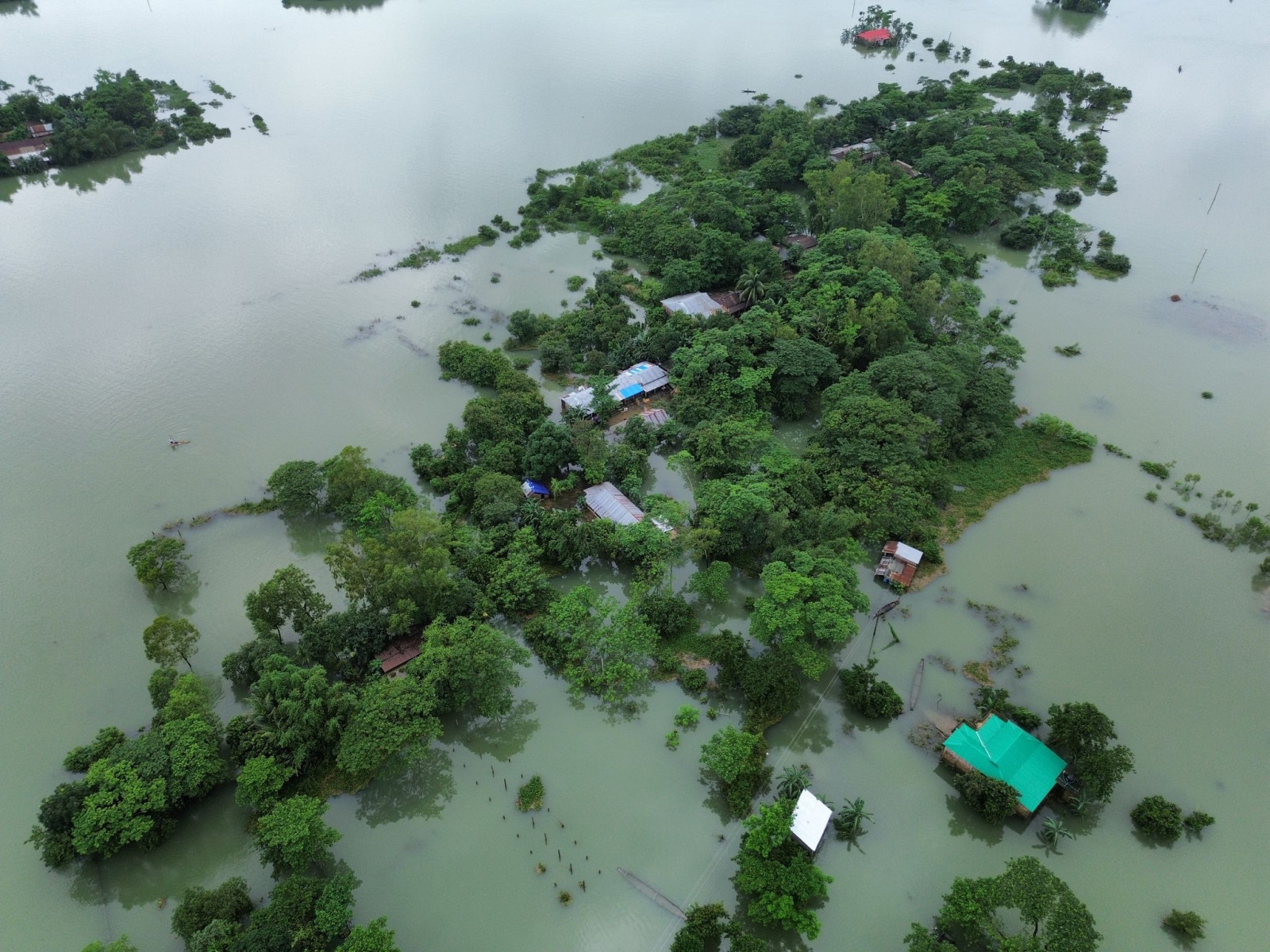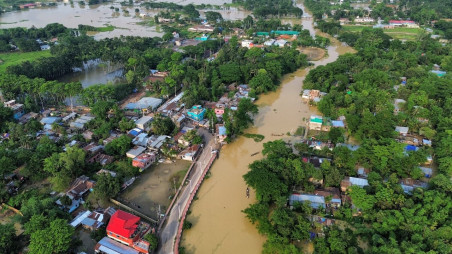What's behind the frequent floods in the northeastern region?
Flood events in Sylhet region have become more severe and frequent due to a cumulative impact of erratic rainfall caused by climate change, riverbed siltation, river encroachment, and the resulting inadequate drainage capacity

Sumon Mia, a rickshaw puller from Sultanpur village in the Sunamganj district, and his children have taken refuge at Sunamganj Primary School after flood destroyed his tin-shed house. His only means of income, the rickshaw, has also been damaged. He, along with his seven family members, is living in hardship at the shelter.
Sumon Mia is not alone. Extensive flooding has stranded around 20 lakh people in northeast Bangladesh this year, following weeks of heavy rains that have submerged homes and devastated farmland. It occurred due to prolonged torrential rain and runoff from the hilly regions upstream near the Indian border, causing four rivers to swell beyond their danger levels.
These millions of people were already haunted by the nightmare from 2022. The northeastern region witnessed a devastating flood that year, triggered by a record rainfall in Cherrapunji, India. It was the most severe flood since 1988. There were a few smaller floods in between. This year, nobody expected another disaster so soon.
According to a study by Grantham Research Institute on Climate Change and the Environment of London School of Economics and Political Science (LSE), around 45% of the population is exposed to high fluvial flood risk, the highest percentage globally.
So, has severe flooding worsened and become more frequent in the northeastern region? What is behind it? Flood events have become more severe due to a cumulative impact of erratic rainfall caused by climate change, riverbed siltation, river encroachment, and inadequate drainage capacity.
Flooding is natural to the geography of low-lying Bangladesh, where approximately 80% of the land consists of floodplains and nearly 700 rivers crisscross the terrain. Moreover, almost two-thirds of the country lies at an elevation of less than 5 metres (16.4 feet) above sea level.

Thus Bangladesh is used to flooding, but climate change is making floods more severe and less predictable. It has altered the pattern of rainfall in the region. A recent study has identified single-day extreme rainfall events as the main cause of recurring flash floods and waterlogging in the Sylhet region.
The study highlights that climate change has significantly increased the frequency of these intense monsoon rains in Bangladesh and northeast India. The Flood Forecasting and Warning Centre (FFWC) recorded about 1900 millimetres of rainfall in June in Sylhet and Sunamganj, which surpassed the earlier historic June rainfall record of 1,737mm in 2022.
However, Gawher Nayeem Wahra, a climate change and disaster management expert, strongly argues that causing floods by our own actions and blaming climate change is a form of deception. He says we are responsible for it.
"We caused this flood. We blocked the paths of flood water flow with illegal settlements and unplanned infrastructure development in drainage basins," Wahra said.
As per Sylhet Water Development Board sources, 111 occupiers have built more than 200 illegal installations occupying a 3.6 km area of the Surma river bank, reported TBS in 2022. As a result, the navigability and width of the rivers in this region have decreased, and their capacity to manage floodwaters has diminished.
The all-weather road in Kishoreganj haors which connects Itna, Mithamoin and Astagram upazilas, has come under controversy. Many believe the road disrupts the free flow of the water in the haor, causing untimely floods. Even the government realised it and decided not to build any such roads in the haors.
However, some experts say it might share a little part of the liability but it is never the only reason.

"In the haor region, many roads, bridges, and culverts have been built. Canals have been filled in, and the rivers have not been dredged. It would not be fair to solely blame the all-weather road. It's at the centre of attention because it's a new topic. However, the regular flooding is a result of cumulative impact," said Dr. Tarekul Islam, Professor at the Institute of Water and Flood Management (IWFM), Bangladesh University of Engineering and Technology (BUET).
The north of Bangladesh is surrounded by the Himalayas and the Meghalaya Plateau. Water from upstream brings silt that obstructs the river's natural flow. As a result, rivers, canals, and wetlands become filled up with silt. If rivers are not dredged regularly, they cannot hold the excess water.
State Minister for Water Resources Ministry Zahid Faruk said a couple of days ago that the government will take steps to dredge the Surma and Kushiara river to protect Sylhet city from early floods.
Meanwhile, the Sunamganj District Water Development Board's 'Haor and Wetland Resources Management Project (Phase 1)' includes proposals for dredging 443 kilometres of rivers and excavating 139.53 kilometres of canals in Sunamganj district to enhance drainage in rivers and canals. But it is still awaiting approval of the Bangladesh Planning Commission.
"In my opinion, just dredging the Surma and Kushiyara rivers will not free us from floods. We need an integrated collaborative approach. But unfortunately, there is a lack of collaboration," said Dipak Ranjan Das, Executive Engineer at Bangladesh Water Development Board (BWDB).
"Highest flood level must be considered for any constructions. However, the Local Government Division does not take any NOC (No-objection certificate) from us before constructing roads. While the roads are below maximum flood level, other constructions follow the same level. As a result they get flooded," he added.
Dr Md Misbah Uddin, Professor, Civil and Environmental Engineering Department of Shahjalal University of Science and Technology, Sylhet, emphasised that the dredging system is not appropriate in our country.
"There are scientific methods for river dredging. It typically involves mathematical modelling to determine the amount. Dredging only a part of a river won't work. The entire river has to be taken under the study," he said.



 Keep updated, follow The Business Standard's Google news channel
Keep updated, follow The Business Standard's Google news channel
















